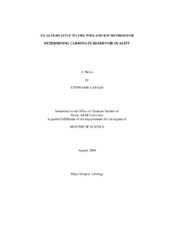| dc.description.abstract | The Winland R35 method [Log R35 = 0.732 + 0.588 (Log Kair) 0.864 (Log O)] is
based on the relationship between porosity, permeability, and pore throat radius at the
point of 35% mercury saturation in capillary pressure measurements and is generally
reliable in rocks with only intergranular porosity (such as sandstone) where pore and
pore throat geometry are related closely to rock texture. Carbonate pores are not
always so; consequently, the Winland method is not as reliable for assessing reservoir
quality in carbonate reservoirs. To evaluate alternatives to the conventional Winland
technique, based on rock facies characteristics, samples from the Jurassic Smackover
Formation in Alabama and the Permian Clearfork Formation in Texas were tested for
reservoir quality with use of the Winland R35 and Pittman methods to determine if
either method is more reliable in carbonate reservoir studies. Pittman's modification of the Winland method was found to be more accurate
graphically. A third method for evaluating reservoir rock character is provided by
Lucia. This method is based on geological rather than petrophysical characteristics,
and it revealed that pore throat sizes at 35% mercury saturation may include a variety
of depositional and diagenetic rock fabrics. The Winland and Pittman petrophysical
evaluation techniques, as well as the Lucia geological evaluation technique - when
based on depositional facies alone - do not provide reliable measures of reservoir
quality. An alternative method based on genetic pore type presented by Ahr in 2005
was tested for comparison. Using a porosity-permeability plot based on the pore
type, the relationship between porosity, permeability, and pore type was found to be
strong and reproducible. When the ratio of permeability to porosity was used in
combination with Ahr genetic pore types, the results indicate that barriers, baffles,
and flow units can be reliably defined. This study demonstrates that the use of pore
types in conjunction with capillary pressure measurements is a more reliable method
for evaluating carbonate reservoirs than any alternative method that is based on
depositional facies or rock fabrics alone. | en |


